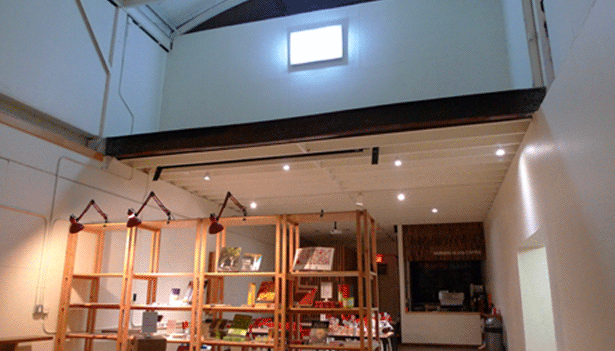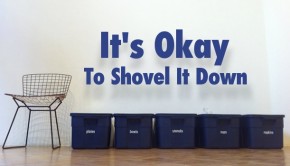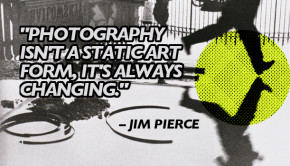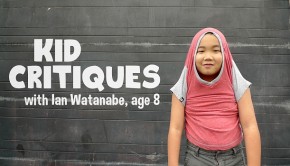There Goes the Neighborhood: an Oral History of R/D
R/D was born on Oct. 5, 2011, and today will be its last day of operation. Over the past two years, the book store/movie theatre/coffee shop/coworking space has connected people and provided a place for them to build things together such as Hello Makana, DCT: Developing Critical Thinkers, Salt + Sand, The Pig and the Lady, The Whole Ox, Paiko, and Sudokrew; the Offsetter was conceived there.
Its ii Gallery exhibited Hawaiian and Hawaii contemporary artists in ways not really seen before in Honolulu (Sean Connelly heaved 32,000 pounds of dirt into the space and made a prism out of it!), and R/D’s movie screen showcased films from Urbanized to Pink Flamingos.
Some have called R/D an institution, but its organizers would say it was an institution that could never afford a staff. Now, its founders, the nonprofit art organization Interisland Terminal, leave on their own terms, headfirst into a new project, Kakaako Agora, down the street and around the corner from R/D’s location.
It’s still unknown what will replace R/D at 691 Auahi St. Among rumors was the clothing company RVCA might open a pop-up there, or that there would be a print-on-demand book store, or a shop for Pow! Wow! Hawaii merchandise. (Morning Glass will pack up its espresso machine and keep the lattes to its Manoa location only, for now.)
Three of R/D’s founders, Sarah Honda, Ben Trevino, and Wei Fang, sat with us to tell us the story of R/D’s origins and to preview Kakaako Agora, the joint project with Japanese architect firm Atelier Bow Wow, scheduled to open in the spring of 2014.
Wei Fang: R/D was Ben’s idea.
Ben Trevino: What? “R/D was Ben’s idea”? Is that true?
WF: Well, the R/D name was his idea.
BT: That’s true! It was my idea. I went to a math and sciences high school, and R/D was this class we had to take as seniors. So when we were thinking of names for the store, I went and sat at the beach in front of the Sunset on the Beach thing and I just thought and I thought and I thought, and the name R/D just came to me, as in a dream!
Sarah Honda: Oh my god, Ben. That’s so dramatic. You know what? R stands for Ben, and D stands for Ben. [laughs]
BT: The way I remember it is, in the previous summer, we had the Green Space pop-up, which was a book store concept, and that was very successful. People loved it. When we were looking around for spaces for our next pop-up, Wei was talking to Kamehameha Schools—they had approached her because they were interested in a development. So then we all talked as a team, as we do, and decided that another bookstore would be something that would be useful to the community, fun to do, and something that would be good for generating money.
WF: We really liked the project because we love print, we love the books that we see as beautiful objects as well as great resources for us as creative people, and that kind of content of product really wasn’t available here. We thought that a coffee bar/book store/coworking concept—
SH: Flexible space—
WF: Not really coworking concept though, because at the time, we didn’t think of it as that; we weren’t thinking of a Box Jelly type of thing.
SH: We definitely talked through the ideas like that, but we wanted it to be for everyone.
BT: The earliest meetings we had were sitting down with Mark Little of Eight Inc. to come up with the concepts of how the space would be designed. We had talked to him about previous design concepts—we had an idea for a temporary movie theatre.
SH: We were going to do a microcinema.
BT: So we had rolled some of that energy in to this new thing that was going to be R/D.
WF: We picked up the space; there was nothing else open here besides the Walk-In Store.
SH: We looked at every single space on the block.
BT: It was the most finished, ironically. We actually ended up taking out most of the stuff that was finished. But there was a floor.
WF: There were no columns in the middle.
SH: It was a stripper store before!
WF: We sometimes still get their mailings. The main concept was always on art, design, and culinary books, and then an open workspace.
SH: Free Wi-Fi.
WF: Those have been consistent throughout time.
BT: The original emphasis was flexibility, but we didn’t know in what proportion to do those things. How much should be coffee? How much should be book shop? The boxes had multiple functions. The original design reflected that necessity.
SH: We opened in October of 2011, and we were thinking we could close in October of 2012.
BT: And if we were going to keep doing it, we’d see how the concept went, and maybe move to a different place. But the things we developed were all meant to expire in a year. Limited shelf life.
WF: Our landlord wanted us to stay, whereas before we were working with them and their schedule. By October of 2012, they were to begin construction here, and we’d have to move out. But their schedule got pushed back, more things were starting to pop up in the neighborhood: Taste Table, The Whole Ox, Night Markets. And so we discussed together with KS and we agreed we’d stay another year, refresh the concept a little bit, take some of things we learned from our first year and improve them in the second year. Things like: the art gallery needed to be connected to the main space.
SH: It was also hard to staff. We had to have multiple people working at the same time to staff the gallery.
WF: The main thing was connecting the two spaces. Another thing was we originally had a big area in the back that was supposed to be our staff meeting office space, but we realized we didn’t need it. We could turn over more space to the public.
SH: When we’re talking about doing the new space, I remember thinking about a better experience for the user here, whether it was air conditioning or better lighting.
BT: Watching a film.
SH: A more comfortable space. We wanted to make it a better experience for the customer.
BT: Chairs with backs.
SH: Moving the retailing component to the front.
WF: Also having an opportunity to work with another architect in town. That was part of our commitment in connecting and pushing a design program.
SH: That’s how we came to work with Kirk Malanchuk and Bundit Kanisthakhon of Tadpole Studios on the refresh.
BT: We had a good first year of events, basically trying out different things people were interested in using. People just wanted a place to do their thing. We hadn’t really figured out what types of programs we were going to do. We had a global game challenge and the bar/d, which was a five course cocktail thing with the Pig and the Lady noodles; films, book talks—I don’t think we’ve had any book talks since we refreshed the space.
SH: You know, when we opened it, it wasn’t where you opened like, any store: This is our lives forever and ever. You know, that’s the goal! But the goal was to open it as a kind of experiment. That’s where R/D, as a title, as our brand, came into place.
BT: It’s also a business experiment. Can we put enough into this thing to get it into orbit, out of gravity’s pull, so that it starts to run itself? And I think we never got it to that point.
WF: There’s different ways to look at it. Why to bring the project to an end. Like Ben’s economic point, when you’re basically giving away something for free, while selling a product that’s notorious for having low margins and being for a niche audience, that’s going to be a challenge to make much money.
SH: And we don’t owe anyone money.
WF: And the fact of the matter is, we also dealt with a whole year of sewer issues, the neighborhood doesn’t have quite enough foot traffic to really allow a lot of the retail business on this block to thrive. So for a business reason, it wouldn’t be prudent for us to keep “R/D”, which is a project of having a book shop and coffee bar and free workspace, open because there we have a fiduciary responsibility. Sarah’s right. We covered all of our expenses; we survived.
SH: Lots of researching and developing work happened here, you know.
WF: And programmatically, if we look at a mission-driven reason as to why we wanted to shut down this program, our organization is not big enough, well-funded enough, where we can do multiple things that well. We’re a small, all-volunteer group. We don’t do a ton of fundraising. We try to cover the cost of our programs through sponsorships, but we’re not tapping a lot of public funds and shit like that. And programmatically, we’ve had lots of other programs and things that are also central to our mission that we have not been able to complete or execute. The Atelier Bow Wow thing is one of them.
SH: By freeing us from this 24/7 project that we’ve attached ourselves to, we’re going to be able to look at all these other programs that were on our back burner and execute those for the community as well. We’ll just be affecting the community in a different way.
WF: From a mission standpoint, I feel like R/D was like, we were in danger of creating a lot of mission drift from it. For example, this bookshop sells more stationery than anything else. We’re not here to sell stationery, as nice as that is, but someone else can sell stationery.
BT: But in the reality of retail, that’s what we’d have to do.
WF: We’d rather spend the energy hosting a discussion about modernism than selling a bunch of Moleskine notebooks. That’s not where our talents are best utilized.
SH: That’s not to say that, as an organization of people, we got a lot of stuff out of it. We learned that people like beards! I mean we’ve met a lot of great people. We joke around about the Kak Block, but we’ve really been fortunate to have been open at the time we’ve been open to know these neighbors, such as Tamara and Courtney at Paiko, Christian and Timo at Bevy, Hank at Hank’s Haute Dogs who has supported us from day one, Mark and Amanda at Taste, Marissa Selders at Quince, Lauren Makk at PAD, Prime and Sierra at 808 Urban.
BT: And all the people we were able to bring in, the Lucky Peach guys!
SH: We can look back and see all of the programs that have happened here. What else did we learn? Sweep first, then mop; only five chairs per rack. [laughs]
WF: We’ve learned that, during the time that we’ve been here, funding for the arts has not increased.
BT: There’s not really any more institutions—
WF: And they’ve not made their programming really any more relevant. We’ve learned something to the effect that we can have really great partnerships with a group like KS.
SH: It was a really positive partnership. It totally was. This wouldn’t have happened without KS. This project happened, and then it’s ending. We really think it’s on a positive note, actually. There’s really a lot in the future for us, a lot in the future for Kakaako. In fact, our next project is in Kakaako. You know, you’re not going to get rid of us that easily, Christian O’Connor. No, I’m just kidding.
WF: We have the journalism series coming up.
BT: That’s like the last R/D project, though.
SH: We should just call that the zombie journalism series. It’s like, you’re open again, what! R/D is, I mean, it’s dead. We’re doing fucking Rest in Peace. So the journalism fest will be in the space formerly occupied by R/D!
WF: You know, we’ve actually been working on Kakaako Agora for about a year now. And I think the fundamentals of that project continued to push the fundamentals of things that we’re interested in as an organization in terms of a mission and our interests. It’s contemporary architecture, it’s a very processed-driven approach, which would involve different folks from different parts of the community who would have authorship in it. We’re working with Atelier Bow Wow; that’s an experienced architecture firm based in Tokyo that has done a lot of experimental things.
SH: They work on really interesting projects.
WF: They deal with public space in an interesting way. They have an interest in cities and public space.
SH: Urban landscape.
WF: So it’s been an interesting experience working with them on this. The project will be completed in the spring, an indoor park on Cooke Street.
SH: It’s a great segue from closing this space. In a broad sense, we’re almost doing the same thing, we’re creating a space. A new space that will have new programming and a new kind of place in this community that people will be able to experience.
WF: The design is more or less finalized, and I think one of the big differences is it’s more publicly accessible than even R/D has been. There’s no commercial element to it; it’s on the street. During operating hours, the big garage doors will be just open. There’s no threshold that you have to cross. It’s really way more public than R/D is. Anyone can walk into it and use it. Hopefully, a wider swath of the population will think of it like a park, or a public plaza. It’s not manned. there’s no—
BT: Management in the constant sense.
WF: There’s nothing to sell there, nothing to buy.
SH: Nothing to steal.
WF: There’ll be places to sit. We still have fundraising to do to complete that project, so we’re starting a Kickstarter to raise money to construct it. KS has committed a certain amount of sponsorship towards it, but we’re doing a lot of cost of construction, the permitting is actually a big cost. Atelier Bow Wow is getting a very under market rate, actually.
So when we proposed to do a project with Atelier Bow Wow that would sort of be a public structure, that could be used by the public, Atelier Bow Wow helped us refine that scope. After their initial site visit, their observation was that we had a lot of great outdoor public space in Hawaii that’s usable year-round, but what we lack, especially in this neighborhood, is shaded indoor public spaces. So their idea was to build an indoor park, rather than to add something to an existing park or to an existing public outdoor space. To convert a private indoor space to a space that would be publicly accessible. Welcoming to people all throughout the day, where shade is a premium.
BT: We’re looking to the public to fill it with whatever they want to fill it with. So it’s like, what problems will we have? Well, we’ll have to look at it when it exists.
WF: R/D was a good project. It was worth doing.
BT: I’m proud of all the programming. I’m proud of all the people we were able to connect, provide resources for.
WF: We were able to show that it was possible, if people want to open up a coffee shop and could break even, to do it!
SH: We hope this isn’t the last coffee shop ever to open. See you at Starbucks! I’m joking. No, don’t write that. Don’t write that! How about, See you at the Walk-In Store! That’s what I’d rather it say, James.
WF: Here’s something that we learned! It proves that when people are willing to share things across industries or purposes it shows that’s how you can make progress here.
SH: With shared ideas or entrepreneurship, the building of things, and ideas being executed.
BT: Physical space is important, but you need to have this space where people randomly run into each other and meet and talk, who will work on things together.
SH: We’re going to miss the physical space, but now we’re just going to meet and go to other physical spaces that other people are running.
R/D will close with a small reception at 3pm on Saturday, Dec. 28, at 691 Auahi St., with a popcorn bar, photo booth, champagne, and presentation on future Interisland Terminal projects.









